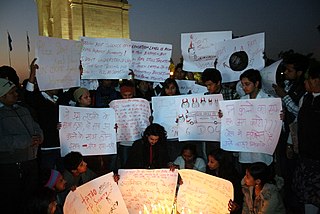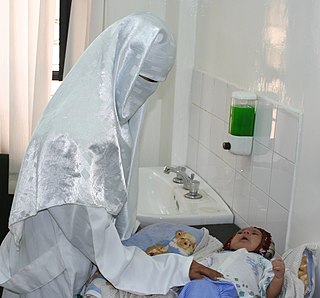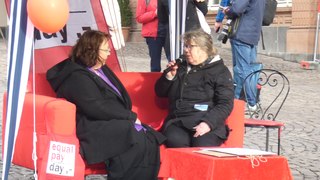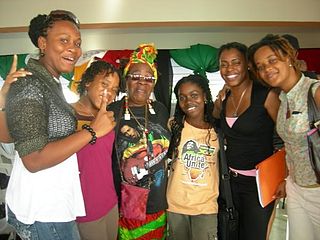Related Research Articles
Gender equality, also known as sexual equality or equality of the sexes, is the state of equal ease of access to resources and opportunities regardless of gender, including economic participation and decision-making; and the state of valuing different behaviors, aspirations and needs equally, regardless of gender.

Feminism in India is a set of movements aimed at defining, establishing, and defending equal political, economic, and social rights and opportunities for women in India. It is the pursuit of women's rights within the society of India. Like their feminist counterparts all over the world, feminists in India seek gender equality: the right to work for equality in wages, the right to equal access to health and education, and equal political rights. Indian feminists also have fought against culture-specific issues within India's patriarchal society, such as inheritance laws.
Gender inequality is the social phenomenon in which people are not treated equally on the basis of gender. This inequality can be caused by gender discrimination or sexism. The treatment may arise from distinctions regarding biology, psychology, or cultural norms prevalent in the society. Some of these distinctions are empirically grounded, while others appear to be social constructs. While current policies around the world cause inequality among individuals, it is women who are most affected. Gender inequality weakens women in many areas such as health, education, and business life. Studies show the different experiences of genders across many domains including education, life expectancy, personality, interests, family life, careers, and political affiliation. Gender inequality is experienced differently across different cultures.
Gender inequality in India refers to health, education, economic and political inequalities between men and women in India. Various international gender inequality indices rank India differently on each of these factors, as well as on a composite basis, and these indices are controversial.

Women in Yemen have historically been placed at a disadvantage due to their gender, with a highly patriarchal society. Although the government of Yemen has made efforts that will improve the rights of women in Yemen, many cultural and religious norms, along with poor enforcement of this legislation from the Yemeni government, have prevented Yemeni women from having equal rights to men.

Women in Thailand were among the first women in Asia who were granted the right to vote in 1932. They are underrepresented in Thai politics. Yingluck Shinawatra, a woman, was prime minister from 2011 to 2014. Factors that affect women's participation in the socio-economic field include "inadequate gender awareness in the policy and planning process" and social stereotyping.
The social and economic changes in Thailand in the past decades have important implications for the quality and quantity of labor. The economic and non-economic roles of women in Thailand can be traced back several hundred years in Thai history, when there were traditional discriminatory attitudes towards women in the culture of Thailand. The transformation of Thailand's social and economic structure since the 1960s led to the gender disparities in Thai society. Recently, the position of Thai women in the labor market has improved a lot in comparison to the past as a result of modernization. In 2011, Thailand ranked 69th out of 143 countries in the Gender Inequality Index. In labor economics, gender inequality is widely discussed in terms of concepts of sex segregation and employment discrimination. Thai government and non-governmental organizations have put forth many policies and programs to address gender inequalities in the last few decades.

Female participation and advancement in majority Muslim countries, or nations in which more than 50% of the population identifies as an adherent of the Islamic faith, have traditionally been areas of controversy. Several Western nations, such as the United States and Western Europe, have criticised majority Muslim nations for the lack of involvement and opportunity for women in the private sector.
Gender inequality in the United States has been diminishing throughout its history and significant advancements towards equality have been made beginning mostly in the early 1900s. However, despite this progress, gender inequality in the United States continues to persist in many forms, including the disparity in women's political representation and participation, occupational segregation, and the unequal distribution of household labor. The alleviation of gender inequality has been the goal of several major pieces of legislation since 1920 and continues to the present day. As of 2021, the World Economic Forum ranks the United States 30th in terms of gender equality out of 149 countries.

The gender pay gap or gender wage gap is the average difference between the remuneration for men and women who are working. Women are generally found to be paid less than men. There are two distinct numbers regarding the pay gap: non-adjusted versus adjusted pay gap. The latter typically takes into account differences in hours worked, occupations chosen, education and job experience. In other words, the adjusted values represent how much women and men make for the same work, while the non-adjusted values represent how much the average man and woman make in total. In the United States, for example, the non-adjusted average woman's annual salary is 79–83% of the average man's salary, compared to 95–99% for the adjusted average salary.

The evolution and history of European women coincide with the evolution and the history of Europe itself. According to the Catalyst, 51.2% of the population of the European Union in 2010 is composed of women.

Women in Trinidad and Tobago are women who were born in, who live in, or are from Trinidad and Tobago. Depending from which island the women came, they may also be called Trinidadian women or Tobagonian women respectively. Women in Trinidad and Tobago excel in various industries and occupations, including micro-enterprise owners, "lawyers, judges, politicians, civil servants, journalists, and calypsonians." Women still dominate the fields of "domestic service, sales, and some light manufacturing."

Gender inequality in Mexico refers to disparate freedoms in health, education, and economic and political abilities between men and women in Mexico. It has been diminishing throughout history, but continues to persist in many forms including the disparity in women's political representation and participation, the gender pay gap, and high rates of domestic violence and femicide. As of 2022, the World Economic Forum ranks Mexico 31st in terms of gender equality out of 146 countries. Structural gender inequality is relatively homogeneous between the Mexican states as there are very few regional differences in the inequalities present.
Nepal, a Himalayan country situated in South Asia, is one of the poor country because of undeveloped resources. It has suffered from political instability and has had undemocratic rule for much of its history. There is a lack of access to basic facilities, people have superstitious beliefs, and there are high levels of gender discrimination. Although the Constitution provides for protection of women, including equal pay for equal work, the Government has not taken significant action to implement its provisions.
Gender equality is the notion that each gender should receive equal treatment in all aspects of life, and that one should not be discriminated based on their sex. Gender equality is a human right, which is recognised under the United Nations Universal Declaration of Human Rights.
The gender pay gap in New Zealand is the difference in the median hourly wages of men and women in New Zealand. In 2020 the gender pay gap is 9.5%. It is an economic indicator used to measure pay equality. The gender pay gap is an official statistic published annually by Stats NZ sourced from the Household Labour Force Survey.

Gender inequality in Sri Lanka is centered on the inequalities that arise between men and women in Sri Lanka. Specifically, these inequalities affect many aspects of women's lives, starting with sex-selective abortions and male preferences, then education and schooling in childhood, which influence job opportunities, property rights, access to health and political participation in adulthood. While Sri Lanka is ranked well on several gender equality indices in comparison to other countries in the region, there are also some sources that question the verity of these indices. However, globally, Sri Lanka ranks relatively lower on gender equality indices. Overall, this pattern of social history that disempowers females produces a cycle of undervaluing females, providing only secondary access to health care and schooling and thus fewer opportunities to take on high level jobs or training, which then exacerbates the issue of low political participation and lowered social rights, a cycle studied and noted on by Dr. Elaine Enarson, a disaster sociologist studying the connection between disaster and the role of women.

Women's empowerment may be defined in several ways, including accepting women's viewpoints, making an effort to seek them and raising the status of women through education, awareness, literacy, and training. Women's empowerment equips and allows women to make life-determining decisions through the different societal problems. They may have the opportunity to re-define gender roles or other such roles, which allow them more freedom to pursue desired goals.
Even in the modern era, gender inequality remains an issue in Japan. In 2015, the country had a per-capita income of US$38,883, ranking 22nd of the 188 countries, and No. 18 in the Human Development Index. In the 2019 Gender Inequality Index report, it was ranked 17th out of the participating 162 countries, ahead of Germany, the UK and the US, performing especially well on the reproductive health and higher education attainment indices. Despite this, gender inequality still exists in Japan due to the persistence of gender norms in Japanese society rooted in traditional religious values and government reforms. Gender-based inequality manifests in various aspects from the family, or ie, to political representation, to education, playing particular roles in employment opportunities and income, and occurs largely as a result of defined roles in traditional and modern Japanese society. Inequality also lies within divorce of heterosexual couples and the marriage of same sex couples due to both a lack of protective divorce laws and the presence of restrictive marriage laws. In consequence to these traditional gender roles, self-rated health surveys show variances in reported poor health, population decline, reinforced gendered education and social expectations, and inequalities in the LGBTQ+ community.
Foreign aid for gender equality in Jordan includes programs funded by governments or non-governmental organizations (NGOs) that aim to empower women, close gender based gaps in opportunity and experience, and promote equal access to education, economic empowerment, and political representation in the Hashemite Kingdom of Jordan.
References
- Helbrig, Adriana; Buranbaeva, Oksana; Mladineo, Vanja (2009). Culture and Customs of Ukraine. London: Greenwood Press. ISBN 978-0-313-34363-6.
- Skutsch, Carl; Lewis, James (2001). The Human Rights Encyclopedia. London: Sharpe Reference. ISBN 0-7656-8023-8.
- In the Crosscurrents. Addressing Discrimination and Inequality in Ukraine. London: Stroma Ltd. 2015. ISBN 978-0-9573458-4-3.
- Women's Participation in Politics and Decision-Making in Ukraine: Strategy Paper (PDF). Kiev: Ukrainian Women’s Fund. 2011.